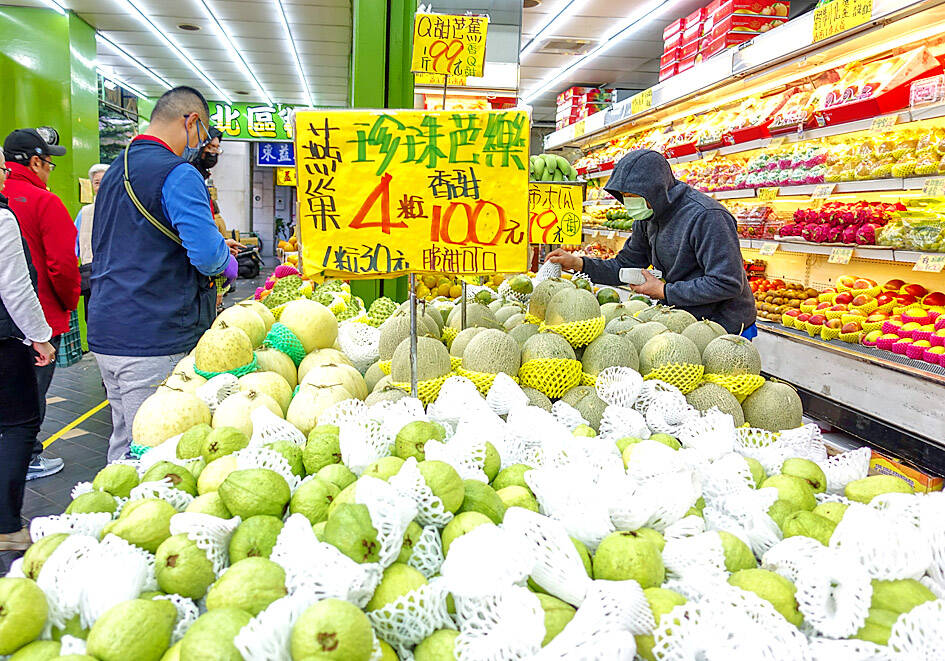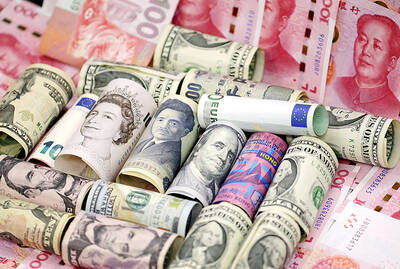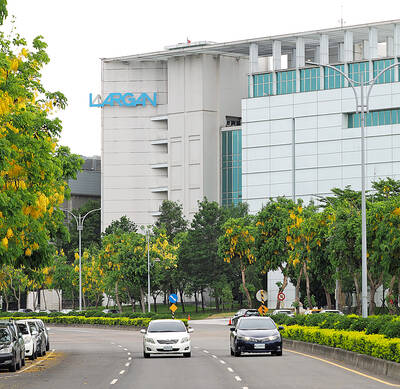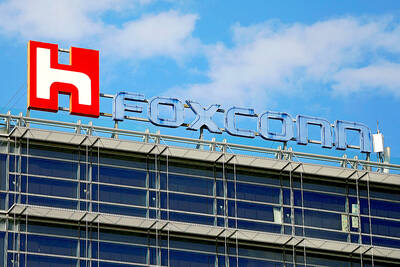The nation’s consumer price index (CPI) last month grew 2.1 percent year-on-year, faster than the central bank’s 2 percent target for the second straight month, as food prices remained elevated on tight supply linked to heavy rainfall, the Directorate-General of Budget, Accounting and Statistics (DGBAS) said yesterday.
The inflationary gauge finished last year with a 2.18 percent hike, exactly the same as the statistics agency projected in November last year, but is likely to begin falling, it said.
“Food prices climbed to a 40-month high of 4.05 percent, while dining costs and rents displayed no signs of deceleration, at 3.03 percent and 2.61 percent respectively,” explaining why inflation turned out worse than expected, DGBAS official Tsao Chih-hung (曹志弘) said, after speculating last month that the CPI would drop below 2 percent.

Photo: CNA
Vegetable prices spiked 30.9 percent year-on-year, as the negative impact of typhoons and rainstorms lingered, Tsao said, adding that fruits, cooking oil and fishery products also picked up noticeably.
Food costs alone pushed up the CPI reading by 1.1 percentage points, he said, calling the uptrend transient, as wholesale food prices had already demonstrated corrections earlier this month.
People might feel the pinch more acutely because prices for frequently purchased items gained 3.12 percent, he added.
Core CPI, a more reliable long-term price tracker as it excludes volatile items, expanded a benign 1.65 percent, Tsao said, adding that the latest CPI data shed 0.02 percent from one month earlier and ticked up only 0.15 percent after seasonal adjustments.
Furthermore, medicine and health, miscellaneous items and shelter costs remained stubborn inflation drivers with increases of 2.44 percent, 2.55 percent and 2.38 percent respectively, he said.
The producer price index (PPI), a measure of the price movements of goods from a seller’s perspective, advanced 2.92 percent, gaining significantly from a revised 1.07 percent in November last year, the DGBAS said.
For the whole of last year, the CPI expanded 2.18 percent, above the central bank’s 2 percent target for the third consecutive year, Tsao said, pinning the blame on service and shelter charges, in addition to food price hikes.
The PPI registered a mild annual rise of 1.35 percent, moderated by international raw material price corrections, he said.
It is noteworthy that the CPI for households comprised of members aged 65 or older hit 2.37 percent last year, higher than the average of 2.18 percent, because they spent more on food as well as medicine and healthcare, the DGBAS said.
The phenomenon is bound to deepen as Taiwan enters a super-aged society this year when people aged 65 and older constitute 20 percent of the population.

Taiwan’s foreign exchange reserves hit a record high at the end of last month, surpassing the US$600 billion mark for the first time, the central bank said yesterday. Last month, the country’s foreign exchange reserves rose US$5.51 billion from a month earlier to reach US$602.94 billion due to an increase in returns from the central bank’s portfolio management, the movement of other foreign currencies in the portfolio against the US dollar and the bank’s efforts to smooth the volatility of the New Taiwan dollar. Department of Foreign Exchange Director-General Eugene Tsai (蔡炯民)said a rate cut cycle launched by the US Federal Reserve

Handset camera lens maker Largan Precision Co (大立光) on Sunday reported a 6.71 percent year-on-year decline in revenue for the third quarter, despite revenue last month hitting the highest level in 11 months. Third-quarter revenue was NT$17.68 billion (US$581.2 million), compared with NT$18.95 billion a year earlier, the company said in a statement. The figure was in line with Yuanta Securities Investment Consulting Co’s (元大投顧) forecast of NT$17.9 billion, but missed the market consensus estimate of NT$18.97 billion. The third-quarter revenue was a 51.44 percent increase from NT$11.67 billion in the second quarter, as the quarter is usually the peak

Nvidia Corp’s major server production partner Hon Hai Precision Industry Co (鴻海精密) reported 10.99 percent year-on-year growth in quarterly sales, signaling healthy demand for artificial intelligence (AI) infrastructure. Revenue totaled NT$2.06 trillion (US$67.72 billion) in the last quarter, in line with analysts’ projections, a company statement said. On a quarterly basis, revenue was up 14.47 percent. Hon Hai’s businesses cover four primary product segments: cloud and networking, smart consumer electronics, computing, and components and other products. Last quarter, “cloud and networking products delivered strong growth, components and other products demonstrated significant growth, while smart consumer electronics and computing products slightly declined,” compared with the

The US government on Wednesday sanctioned more than two dozen companies in China, Turkey and the United Arab Emirates, including offshoots of a US chip firm, accusing the businesses of providing illicit support to Iran’s military or proxies. The US Department of Commerce included two subsidiaries of US-based chip distributor Arrow Electronics Inc (艾睿電子) on its so-called entity list published on the federal register for facilitating purchases by Iran’s proxies of US tech. Arrow spokesman John Hourigan said that the subsidiaries have been operating in full compliance with US export control regulations and his company is discussing with the US Bureau of